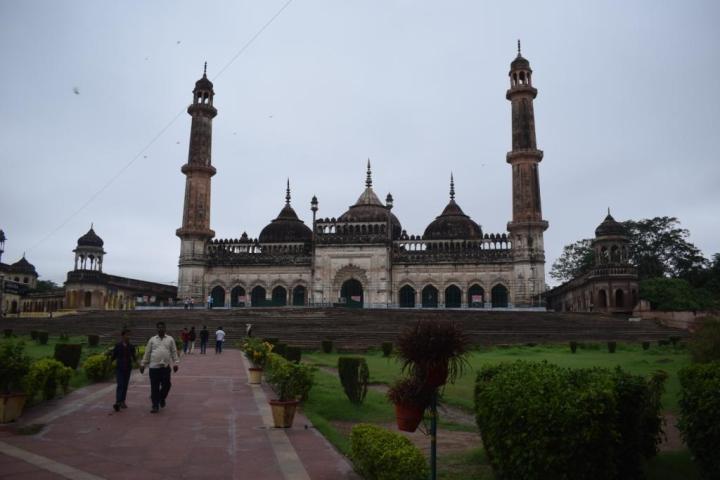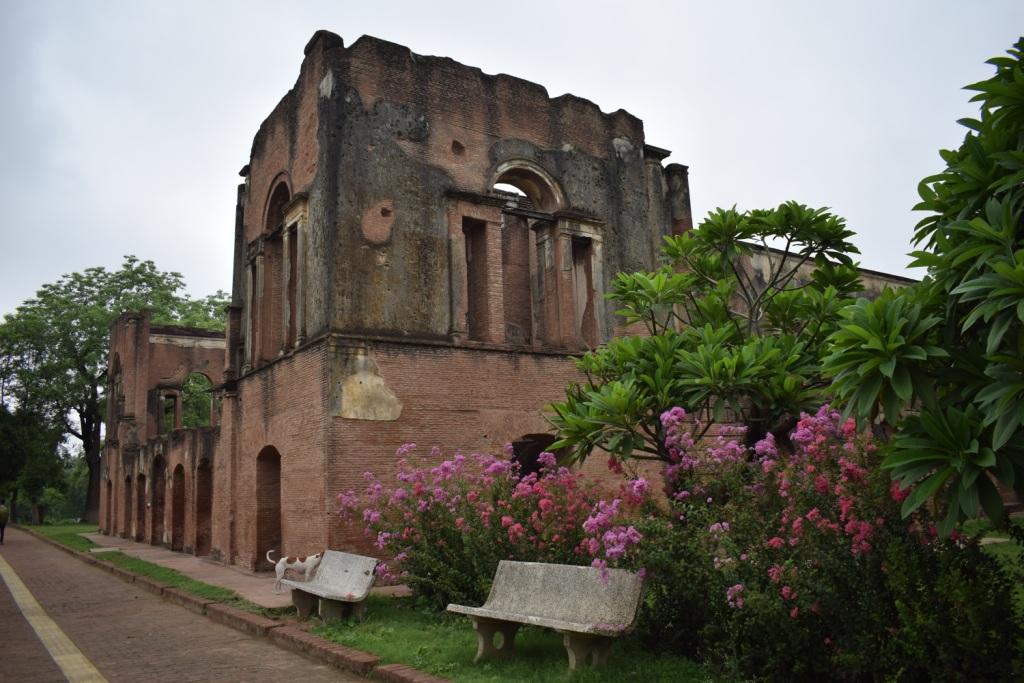The bustling capital of Uttar Pradesh lures history and culture lovers with its Instaworthy spots

Words & photographs: Ambica Gulati
Steeped in Nawabi culture, the city was touted as the ‘17th fastest growing city in India and 74th in the world’ in 2015. With roots supposedly going to the Ramayana era, Lucknow is where stories lie in every nook and corner.
Legend goes that Lakshman had a palace here called Lakshmanapuri, so the city was called Lakshmanpuri. But Dalits say Dalit ruler Lakhan Pasi settled here. Different eras and different names (from Lakhanpur (or Lachhmanpur), Lakshmanavati , Lakhanavati, Lakhnautim Lakhnau to finally the anglicised modern-day Lucknow), but the city just evolved with each era.
From 1350 onwards, the Awadhi region was ruled by the Delhi Sultanate, Sharqi Sultanate, Mughal Empire, Nawabs of Awadh, the British East India Company and the British Raj, respectively. Like the rest of Mughal regions, Lucknow too was embroiled in battles with the British until the Indian Independence in 1947. But they couldn’t wash out the impact of 80 years of Nawabi rule.
Armed with a guide by Tornos India, we stepped back in time.
The Residency
Located in the heart of the city, the green ruins were the residence of the British Resident General, a representative in the court of the Nawab. The Residency was constructed by the fifth nawab–Nawab Saadat Ali Khan II—between 1780 and 1800 AD. But battles and cannon shots tell the tales of the siege that took place between July -November 1857, as the Indian Rebellion of 1857 rose. There is even a mosque in the premises and a dargah of a priest who refused to leave the area. Every Thursday, people gather to offer their prayers. The graveyard has graves of over 2000 men, women and children, including that of Sir Henry Montgomery Lawrence.
Red ruins, dark clouds and stories in every brick, the Residency could have been a gloomy ground but for the fact that it is surrounded by prominent buildings such as Shaheed Smarak, Tehri Kothi and High Court Building. A light and sound show is held every evening.
Imambaras & Rumi Darwaza

Even as the eyes quickly ran over horse carriages for tourists and 60-feet high Rumi Darwaza, we first explored the magnificent Imambara complex. Built by Asaf-ud-Daula, the Nawab of Awadh, in 1784, it is claimed to be the grandest building in Lucknow. The coolest thing here, or probably the scariest without a guide, is the labyrinth or bhool bhulaiya with 489 doorways. There are said to be 1024 ways to reach the terrace (which offers such a beautiful view of the city) but only one to come back. It’s been called ‘accidental architecture’.
The building was constructed during a famine in 1785 to provide employment to the people. Folk tales say that the workers would work in the day and elite would break that work at night and the project dragged on while the famine lasted. The entire cost for this complex was between half a million and a million rupees, and it was completed in 1791. After that the Nawab would spend Rs 4, 00,000-5, 00,000 annually to decorate it.
The highlight of this Imambara is the 50X60m wide and over 15m tall chamber or hall without beams and pillars. The tomb of the Nawab is also here. It is used for Azadari or the mourning that takes places during Muharram. The mosque is off limits for tourists and non-Muslims. There is a bowli and blocked tunnel too.

Walking out towards the Turkish Gate or Rumi Darwaza, it is perhaps the place where the most photographs are taken. This grand gate is modelled on the Sublime Porte (Bab-iHümayun) in Istanbul. Once this was the entrance to Old Lucknow.
A few metres away is Chota Imambara. The man who got it constructed, Muhammad Ali Shah, is buried with his mother here. Arabic calligraphy on the outside walls and gardens with fountains make this a beautiful place. Added to this, are the chandeliers from Belgium. Many refer to it as a palace of lights for they come alive on important occasions. Like the Bara Imambara, it also houses the tazis.
Qaisar Bagh
An elaborate and marvellous complex, this was conceptualised as paradise by Nawab Wajid Ali Shah. The construction began in 1847 when he came to power. Now, only the Paree Khana where the queens stayed, Safed Baradari and some remnants of Lakhi Gate remain.
While some say the Baradari was a place used for mournings, others call it the cultural centre. But right now, it’s used for banquets, weddings and parties. It was named Qasr-ul-Aza by the Nawab. After the annexation of Awadh, the British held court here in 1856. In 1923, it was handed over to the Taluqadars of Awadh. This was in appreciation and loyalty to the Queen of England and for their ‘anjuman’ or association, renamed as the British India Association of Oudh.
Lakhi Gate is a sad state for it is supposed to be under the government. But a nameplate shows that one of its pillars is the home of a lawyer.
Then the rain gods came down on Earth and we had to forgo the food walk in the old city and through the famous La Martienere College. And I brought home memories on an overnight journey by bus.
How to reach
By air: There are regular flights from major cities to Amausi Airport.
By train: Well connected with the rest of the country. Railway Station(s): Lucknow Charbagh, Badshahnagar, Lucknow Junction, Alamnagar, Malhour, Utraitia Junction, Gomati Nagar, Lucknow City, Aishbagh, Daliganj.
By bus: There are state and private buses from Delhi and other major cities. State bus terminal is at Alambagh.
Navigating through Lucknow
Public transport: There are buses, auto rickshaws and taxis.
Famous for: Mango Festival, (more in this post), Kathak, Literature and Poetry festivals, Chikankari


I really loved your detailed description of the place with photos and videos. That’s a very good guide for new commers and me, personally feel convinced to visit this place.
LikeLike
Thank you. It’s nice to be of help!
LikeLike
I have visited Lucknow several times when I was in India and I love the culture and all it has to offer. The food is just out of this world and the Awadhi cuisine leads the way by far. The architecture is something else which has always appealed to me with the Imambara’s that have such a grand and opulent aspect to it. I would love to visit it again and thanks for bringing back a lot of memories.
LikeLike
I’ve never thought of visiting Lucknow before but your photos are great. I love the look of the old buildings, they look beautiful. Intrigued to know more about the mango festival.
LikeLike
Post to be up soon on the mango fest.
LikeLike
I have never been to India but I do love reading posts of places in this country that are not the usual tourist spots. This place sounds amazing! I’d love to visit Imambara complex and check out the labyrinth with the 489 doorways! I’d get lost on purpose just to feel what it was like being in there:)
LikeLike
You are brave. The labyrinth can be a little scary in places
LikeLike
I am amazed at the “accidental architecture” of the 1024 ways to reach the terrace. It’s such an intriguing story. The entire city seems to be filled with so many stories and such a depth of history.
LikeLike
History for sure is the forte of this country.
LikeLike
So good to see your article on my hometown Lucknow. Growing up here, I have heard how it was originally called Lakshmanapuri. Given the proximity to Ayodhya, I will not be surprised it that is true. Of all the places you have mentioned, I am most fond of Residency. It is a very important stop for those who are interested in Indian freedom struggle. Still many British descendents come here to pay homage to their ancestors who perished in the violent mutiny of 1857.
LikeLike
While I find a lot of history very turbulent, I do like the way they have kept it now. It’s very green.
LikeLike
True. Very well maintained. History was never a pleasant subject haha.
LikeLiked by 1 person
Lucknow is one of the cities very close to my heart. I have spent 13 years of my childhood there. It is my favorite place of Chikankari works and Biryani. I remember, whenever guests would visit us home, we would take them to Bada Imambara, Chota Imambara, Residency and Zoo. I love going back to these places even now.
LikeLike
Wow. I wish I had known. Would have asked you for some tips before going.
LikeLike
After reading a lot of posts about India, we’re finally visiting this December. I would have to check if we can also visit Lucknow. The Qaisar Bagh looks amazing and I would love to see it personally.
LikeLike
All the best,I hope you do get to see the history of Lucknow .
LikeLike
I never thought to visit Lucknow. Never heard of it till now. I do appreciate the history. It would be something great to learn about. The pictures do it justice.
LikeLike